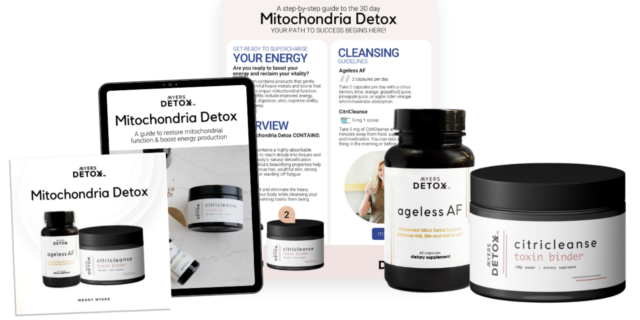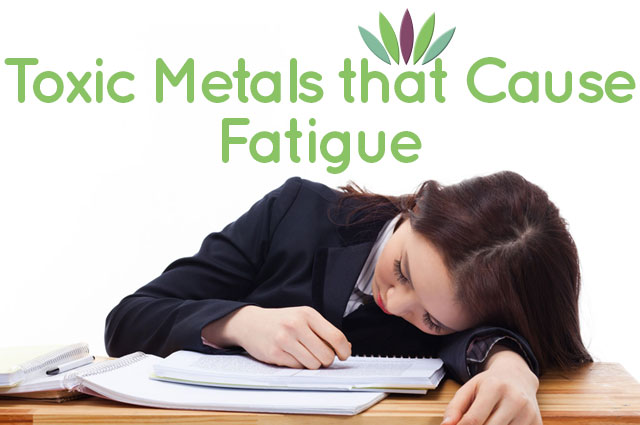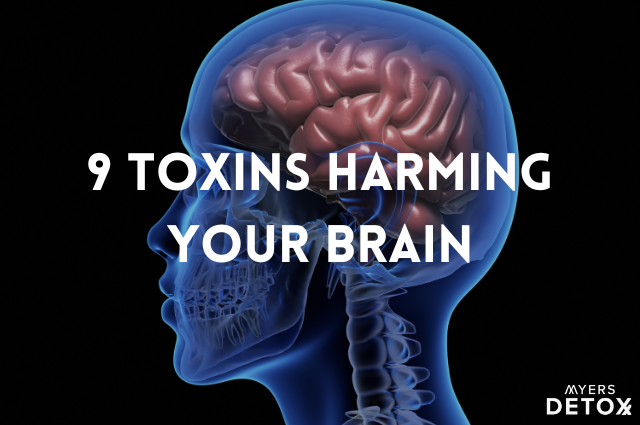Fatigue is the first sign something’s not working properly in your body. And people will turn to coffee. They’ll turn to stimulants. I totally get it. I’ve been there myself.
But if you are suffering from chronic fatigue, toxic metals may be to blame!
Are you constantly tired, even though you are eating right, doing regular workouts, and getting ample sleep? Well, it might not be not your fault. Metals like arsenic, aluminum, and thallium may be killing your body’s ability to produce energy! Think of them as energy vampires.
Metal toxicity is an ever-growing threat in modern industrialized society. This toxicity doesn’t just sap your energy; it doesn’t even let you produce energy. That’s right: metals can block energy production in cells.
How Your Body Produces Energy
To understand it, let’s begin by looking at how the cells of our body produce energy. We have tiny organelles called mitochondria in our cells. They are our biobatteries. They produce energy by releasing it from the food we eat. Through a process called electron transport chain, they combine the oxygen we breathe and produce ATP, or energy, molecules.
ATP, short for adenosine triphosphate, is the biocharged molecule that gives us energy for all our activities.
This is the reason you breathe and why you gasp for air when you engage in heavy activities like running. Mitochondria need oxygen to churn out ATP energy and meet your needs.
It all begins with the sun. We walk, talk, run, work, and do all our activities because of the sun. This is why it’s a very important part of energy production to spend time in the sun daily if you’re able.
If you remember from science class, the energy cycle begins with plants. Plants are capable of converting solar energy into bioenergy through photosynthesis. They use the energy for their own purposes and store the rest in the form of sugar and other biological forms. This stored energy is passed on through the food chain.
All animals that eat plants – and all animals that prey on plant-eating animals – release this energy using their own mitochondria. We, humans, are part of this energy cycle and we release our energy the same way as all the animals.
Toxic metals can cause mitochondrial dysfunction (1). And are a major reason you’re tired.
Metals attack mitochondria in two ways: 1) they weaken or prevent ATP production and 2) impair the antioxidant systems. Mitochondria have their own antioxidant defense systems such as superoxide dismutase and glutathione, along with its derivatives glutathione disulfide, glutathione peroxidase, and glutathione reductase.
Mitochondria are the major source of free radical production and they need these antioxidants to remove them, which otherwise are destructive to mitochondria. Metals are one of the body’s primary sources of oxidative stress to the body. It takes a lot of the body’s energy to remove them.
Have you ever wondered why a girl who eats very little and is very active throughout the day? Where is she getting the energy from? Or what about that boy who is eating a lot but is always slouching and slow? Where does all the food go? You may be thinking, “I’m eating a healthy diet but I don’t have the energy to be as active as I want to be!”
This is because mitochondria determine whether you are an active person or someone who is always fatigued.
The girl’s mitochondria are efficient in producing energy but, in many others who are fatigued, the food just passes through the system without producing much energy. Metal toxicity is a very likely culprit. No matter how healthy your diet, exercise, sleep and supplementation, toxic metals are throwing a monkey wrench into your ATP synthesis machine and preventing energy production.
Dysfunctional mitochondria lead to fatigue and in many cases severe chronic fatigue.
Are You Suffering from Metal Toxicity?
In short: yes. We all are. Metal toxicity has become unavoidable in this day in age. The industrial revolution brought about the widespread use of metals in industrial, domestic, agricultural, medical, and technological applications. They are being mined from the earth and then get into our air, food and water.
Metal poisoning is, in fact, on the rise in alarming proportions because of frequent exposure to industrial wastes in air, water, pollution, food, medicine, paint, and the million conveniences that surround us in modern life.
The amount of metal toxicity depends upon our absorbed dose, the route of our exposure, and duration of exposure. Insidiously, as you become more toxic, metals can reduce your body’s ability to detox them! As your liver, kidneys, colon, skin and other detox organs become riddled with metals, your ability to detox new metals you accumulate is drastically reduced. Some people due to genetic issues can become incapacitated from metal toxicity and suffer chronic fatigue because their bodies simply cannot detox metals.
But the fact remains that no matter how vigilant one is with their health, no one can avoid absorbing toxins in air, food and water.
The following metals are notorious for causing fatigue.
Arsenic
Arsenic makes you tired. Period. Arsenic is an incredibly toxic metal that has been classified as human carcinogen by the U.S. Environmental Protection Agency and the International Agency for Research on Cancer. And despite the threat it poses to our health, it is everywhere!
First: arsenic is found in drinking water. A recent study estimates that over 4 million individuals in the US, and over 140 million worldwide, expose themselves to arsenic-contaminated drinking water without even knowing it (2). Well water is a common source of arsenic.
But that’s not all: arsenic is found in the the air, soils, and even our food! The list of arsenic sources is seemingly endless.
Arsenic impairs mitochondrial function by affecting various mitochondrial enzymes. Most of its toxicity results from interacting with sulfhydryl groups of proteins and enzymes, and some from replacing phosphorous in many biochemical reactions (3).
Arsenic inactivates essential enzymes of mitochondrial function, such as dihydrolipoyl dehydrogenase and thiolase (4, 5). Arsenic further affects mitochondrial function by binding and depleting lipoic acid in cells, interfering with the production of ATP. It can also directly bind to and inactivate ATP (6).
All these result in the inability to produce energy, which then causes:
- acute and chronic fatigue
- muscle weakness
- headaches
- drowsiness
- confusion
- seizures
- cell death
In addition to affecting mitochondrial enzymes, arsenic directly affects muscle and muscle fibers, causing severe fatigue (7). Those arsenic-affected muscles not only have decreased resistance to fatigue, but also a decreased recovery ability from fatigue.
There are many other complications that result from arsenic toxicity, such as brain damage (encephalopathy), nerve disease of the extremities (peripheral neuropathy), hemorrhages within the white matter, and even loss myelin shields of the nerve fibers (demyelination). To name just a few.
Learn more about arsenic toxicity.
Aluminum
Aluminum is the most common metal in the earth’s crust. As a result, everyone is aluminum toxic. Aluminum is used to manufacture beverage cans and cookware. It’s added to flour, salt and sugar and municipal water sources. And you’re slathering it on your armpits every day! Duh.
We are exposed to aluminum through drinking water, food, the air, and even cooking utensils.
In the United States, the average adult ingests 7–9mg aluminum each day, mainly through food, air, and drinking water (8). This amount is simply shocking! And over time this adds up to so much neurotoxic aluminum, that it’s not surprising that roughly 50% of the US population eventually suffers from some form of dementia later in life.
Aluminum toxicity affects glutathione production – the major mitochondrial antioxidant – which is necessary for reversing oxidative stress. Most of the damage by aluminum to mitochondria is caused by aluminum radicals.
Aluminum radicals deplete mitochondrial iron content, which leads to generation of free oxygen radicals (9). These oxygen radicals causes serious oxidative damage, which ultimately kills the cells.
Aluminum toxicity can cause:
- extreme exhaustion
- chronic fatigue
- breathing disorders
- muscle weakness
- sleep disorder
Aluminum toxicity can also cause cell death because of the free radicals generated by aluminum itself. It’s important to realize that aluminum toxicity affects, not only mitochondria, but also the resulting cell death can wreak widespread havoc on the body, causing such things as:
- bowel dysfunction
- cardiac complications
- liver dysfunctions
- weakened immune system
- brain disorders
- Alzheimer’s disease
- Parkinson’s disease
For more information on this toxic metal, please visit our page to learn more about aluminum toxicity.
Thallium
Thallium is an extremely toxic metal that reduces our ability to produce energy and contributor to adrenal fatigue. Thallium is in fact ten times more toxic than mercury.
How is it used? Well, to start, it is used in industrial processing of cement. Thallium is also added to gasoline and released into the air by car exhaust. That is why thallium toxicity is extremely prevalent in those who live in urban environments.
You are also exposed to thallium every time you eat foods harvested from contaminated soils. One particular culprit is kale. Eaten in moderation, it is fine but the tasty and trendy cruciferous vegetable can be hazardous to your health when eaten in abundance.
A 2006 study found that the cruciferous family of vegetables – kale, cabbage, cauliflower, and broccoli – to be hyper-acculumators of thallium, with kale being particularly potent in thallium, even when the soil it was grown in was low in thallium. The reason behind this is still unknown, but one current hypothesis is that organic kale is higher in sulfur, which is known to attract thallium (13).
Thallium bioacculumates, meaning, it builds up in the body over time. It can make its way into the body, not only through consumption, but also via skin exposure and inhalation (10).
Thallium is a potent mitochondrial poison. It enters mitochondria passively, then causes the mitochondria to swell by accumulating inside. That then causes a decrease in ATP production and increase in reactive oxygen species formation, glutathione oxidation, and in brain decreases in dopamine and serotonin levels (10-12).
Thallium poisoning causes extreme and unrelenting fatigue. It blocks potassium channels in the body and causes so many different problems as a result. People with serious mitochondrial dysfunction from thallium can experience:
- Muscle weakness and pain
- Gastro-intestinal disorders
- Loss of motor control
- Cardiac disease
- Liver disease
- Respiratory illness
- Seizures
- Visual/hearing problems
- Lactic acidosis
- Susceptibility to infection.
Thallium-poisoned people can also experience extreme drowsiness, nausea, vomiting, and abdominal pain. Some lose most (or all) of their scalp hair. They also will have rapidly progressing and painful sensory polyneuropathy, motor neuropathy, cranial nerve palsies, seizures, impaired ability to coordinate voluntary movements, and mental retardation.
Please visit our page to learn more about the thallium toxicity.
Detox Is Your Path to Greater Energy
I have researched and studied these metals and their effect on the body for years. What I’ve learned is that – bottom line – toxic metals are really what are causing your lack of energy. There’s no amount of coffee that’s going to cover this up. There is no quick fix. Sure, you can keep covering it up, but not for long because it will always come back to get you. The main path to greater energy is detox.
So if you want to really help yourself get rid of fatigue and brain fog, as well as produce the amount of energy that will meet your needs (and more!), these metals must be purged from your system and replaced with the minerals your body needs for optimal health and energy.
But how do you do that? Let me show you so that you can begin living the life that you desire and deserve. It all begins with detoxing your mitochondria.
How to Detox the Metals Causing Fatigue
As we have learned, there are certain heavy metals notorious for causing fatigue – arsenic, aluminum, and thallium – because each of these heavy metals are potent mitochondrial poisons. They poison the enzymes that transport nutrients into your cell’s mitochondria, aka the body’s energy manufacturers. In this way, it renders your ATP energy manufacturers unable to product energy as effectively. The result is chronic, unrelenting fatigue.
That’s why I developed my Mitochondria Detox supplement kit. It effectively detoxes these dangerous mitochondrial poisons. My Mitochondria Detox includes:
- Ageless AF
- CitriCleanse grapefruit citrus pectin
First there’s a potent kind of silica, orthosilicic acid (OSA). which is found in my Ageless AF.
OSA can help facilitate the body’s natural excretion of the pollutants from your system that mess with your energy production and is incredibly effective at supporting your body’s natural ability to keep the body’s toxic metal burden low.
Ageless AF also contains selenium (a potent antioxidant to fend off oxidative stress), hyaluronic acid (HA) (which helps your cells retain moisture for dewey, glowing skin). and biotin (which is crucial for the production of keratin, a protein that acts like the building blocks of strong hair and nails).
Ageless AF is gentle on the system and works to keep a range of trivalentmetals – including thallium, aluminum, arsenic, bismuth, tin and cesium – out of the body so that you can maintain normal health and support your mitochondrial health.
Next comes CitriCleanse.
When supporting your body’s natural ability to mobilize these toxins and keep them from being absorbed by your tissues, it’s wise to use a binder to help ensure that they are flushed out normally. This helps prevent the contaminants from being reabsorbed or redistributed elsewhere in the body.
For this purpose, I use my CitriCleanse grapefruit citrus pectin (the second product in the Mitochondria Detox kit).
The grapefruit citrus pectin in CitriCleanse is amazingly effective at aiding your body’s innate ability to mobilize and excrete these impurities. It has been processed in a way that makes its molecules small enough to cross the intestinal barrier and to get into the bloodstream. This allows the grapefruit citrus pectin to gently surround and support the excretion of contaminants that are both freely circulating in your bloodstream as well the ones that have become lodged in tissues and organs.
You can get both of these products, including instructions on how to use them for the most effective heavy metal detox, at MitochondriaDetox.com. Together, Ageless AF and CitriCleanse are an effective two-step process to help you detox the heavy metals weighing you down and causing fatigue. I recommend my Mitochondria Detox kit to any clients currently suffering from heavy metal toxicity.

What happens when I detoxify metals?
Have you noticed that some people are hyperactive and can’t sit still? That’s because their energy has to be spent. You can’t stop a machine from running while the power is still on.
If you want to generate limitless energy and be as active as you desire, you must detoxify to get rid of metal toxins. You’ll naturally be energetic and active once you do!
You need energy to meet family obligations and do all your work successfully. You need energy to meet your goals and tend to your hobbies. With your mitochondria efficiently producing energy, you can easily accomplish your goals and live the life you of which you’ve always dreamed.
Get started today with my Mitochondria Detox kit.









